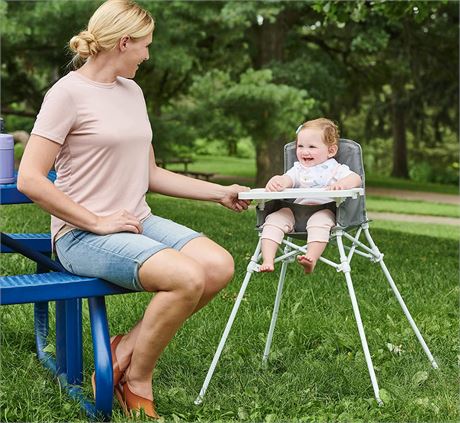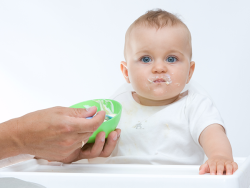Sunny Gault 0:00
You've been pureeing foods and giving your baby the "soft stuff" for a while now and you're thinking about transitioning to solids. But how do you know your baby is ready? And also how do you know if you're ready because moms... you are a big part of this. Hi everyone. I'm Sunny with New Mommy Media and I'm joined today by Mallory Millet. She is an infant feeding specialist and her website is The Feeding Mom. Hi Mallory. Thanks for being with us today.
Mallory Millet 0:26
Hello, thanks for having me.
Sunny Gault 0:28
Alright, so Mallory, when it comes to feeding our baby solids, what are some things that moms should consider just to make sure that everybody is ready for this next step?
Mallory Millet 0:40
I think that I mean, this is like a big one, right? The transitioning into solids just causes so much anxiety and stress for a lot of moms. I think there's two things that I tell every single mom or parent who's starting solids is take a course that talks about choking versus gagging, think a lot of parents see a gag reflex and just lose it. And gagging is so important for baby brain to learn what to do and how to manipulate foods. And it's just an important piece of learning for them. So gagging is okay. And seeing the differences and learning the differences can just make a huge difference to parent. The second thing I say is, baby is safer. Learning how to eat solids if they're introduced to them, right? Babies safer walking, when they learn how to walk, you have to learn to eat. And so giving them these foods earlier on teaches them that not all food feels the same. Not all food needs to be manipulated in the same way. Not all food requires the same amount of work. And the earlier they realize that the more protective they are of their airway. They know Oh, they need to take a bite and feel it and learn it and decide what do I need to do to process this food. And that helps decrease chokey risks.
Sunny Gault 2:15
Yeah, and that's a really good point. Because I feel like a lot of times As parents, we don't want our kids to go through even that learning process that you're talking about. Right? Because gagging is different than choking. And if we don't let our kids experience some of this, how in the world are they going to know the difference? But as parents I know, that was one of my greatest fears is that oh my gosh, really, they were just gagging a little bit. And I you know, I guess, you know, jump to the worst thing that could possibly happen to my child turning blue in the face and all of that. But sometimes we need to let this breathe a little bit. No pun intended, right?
Mallory Millet 2:50
Yeah, I mean it, it can be really tough. I mean, I'm an infant feeding specialist, right? All I do is feed babies all day long. And even and, you know, the other thing is to realize that choking risks never go away. I knew, you know, a man in his 50s who died from choking, and he's been eating his whole life. Okay, so those choking risks Don't go away, I have my oldest is now five. And sometimes when he's playing around, or he's not paying attention to what he's eating, I'm looking at him and anticipating the worst. But we do that as parents, that's all we do is anticipate the worst and everything. So those fears are never going to completely go away. But we can't inhibit progress because of our fears. We need to learn to manage that. Right.
Sunny Gault 3:39
And Mallory, what are some ways to ease into this whole transitional phase? Right? So I mentioned earlier, you know, you're feeding the puree stuff, you know that the mushy stuff, perhaps or maybe coming out of breastfeeding a little bit. And suddenly we're going into this solid phase. I mean, we're not just going to hand them a carrot or... are we doing that, I don't know. You tell me... what do we do?
Mallory Millet 4:02
Yes, right, that's exactly what we're gonna do. We're gonna give them a raw carrot, and I'm being serious. So the whole key to feeding no matter how you start is making sure it's a responsive relationship. So you are not holding the spoon, if you want to load the spoon for them and hand it to them where they're bringing it to their mouth, that is developing a responsive feeding relationship, okay? I understand sometimes you just don't, they can't get dirty. They just put their church clothes on. Like they can't get dirty right now. So you feed them. So if you're feeding them in that type of situation, you can still be responsive. You hold the spoon out, you wait for them to lead into you. You don't swipe the top, you put it in their mouth, they pull away and they're controlling the process still. Okay, so how do we Move from this soft food to textures is to add some texture into your soft food. If you put some chia seeds in a puree, all you're doing is teaching them that foods can feel different in the mouth. But chia seeds are not a choking hazard. So sometimes that relieves some tension from parents, right? Giving them raw veggies that they can't bite off. So a big raw carrot stick a celery stick, bell pepper slices, you let them play around in that puree lifted up to their mouth. Now they're chewing on something that's hard. So we're working those jaw muscles, but then they're swallowing the puree. So now we have this motor plan developing, right? We chew, we feel the food, and then we swallow it. And then you can move into take, let's say you have pureed peas, bones that have puree in them, smash them with your finger, okay, and then let baby pick up those smashed pieces of food. And now we have a whole different texture. And then when parents sees how good they are moving the food around, then they feel more comfortable progressing those foods slowly. I don't ever want parents to think that there's a food that's off limits. It's all about how you present it. And there's no food that you can't give. It's how we can manipulate it to make it safe for what baby has done so far.
Sunny Gault 6:37
Okay. And how long should this process take? It obviously depends, you know, there's a lot of factors involved. But should parents kind of be in this transitional phase for a certain period of time? Or what are some general guidelines you can give them?
Mallory Millet 6:52
So the piece to remember to that question is that the longer baby is on just pureed foods, the higher the chance there is for an aversion or picky eating, or anything that's outside the normal kind of typical feeding behaviors. So we do want to transition pretty quickly. If you the problem that happens is parents give, you know, smashed food, let's say they smash it with their fingers, and they give it to baby and baby can't handle that, like they get stuck there gagging all the time. They're not learning, it's the same thing over and over. I don't want parents to sit in that phase, and just say, oh, baby's not ready to go back to puree, they may need a little more help, we may need more assistance, there might be something else going on. And so if you're it depends on age. If you're starting at four months with your puree, raw, just sitting them in the seat, getting them used to the routine, then you have a much longer grace period where you can use those soft solids and really develop motor skills for a longer period of time. If you start at six months, then at six and a half months, I want to start seeing some smashable food. At seven months, I want to start seeing them picking up that smashable food that's not smashed yet and smashing it themselves once they put it in their mouth, right. And so that process just speeds up a tad bit. Because we, the longer they're on puree, the harder it is for them to adjust.
Sunny Gault 8:40
Okay. Yeah, and I would imagine that kind of picks up pace, like once they get the hang of things, you know, they probably like being more assertive, and you know, being more involved in this whole process.
Mallory Millet 8:51
And once parents see how they move food and can manipulate different things, they become more relaxed too. And so the kind of rule is, it's either you know, the length of your two fingers with wise where they can grab it and sort of munch on it. So like a banana strip where they can grab and kind of munch on it. Broccoli stalks that are seemed really nice, they grab that broccoli stalk and sort of munch on it. Or it's the size it's a size where they can pick up place in their mouth, and if you can smash it with your fingers, they can smash it with their gums. So just think of those rules kind of as like a starting point.
Sunny Gault 9:34
Okay, sounds good. Thank you, Mallory. Now if you guys want to learn more about Mallory, you can visit her website. It's http://www.thefeedingmom.com. She has online courses, she also does one-on-one video consultations. So moms if you're struggling with any of the things that we're talking about today, Mallory would be happy to meet with you. And you can learn more on her website. We also want to thank our sponsor, Regalo Baby. If you guys want to save 25% and all of the items on their website plus free shipping, check out our video description. We have a special promo code and when you use that you get the big discount. You can check out our website https://newmommymedia.com- we have a lot of different podcasts on there and more great videos like this one. It's where real moms talk about real life.








